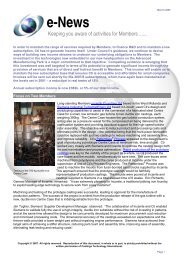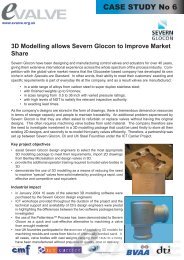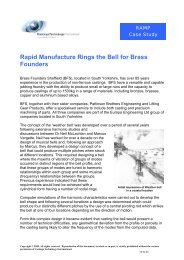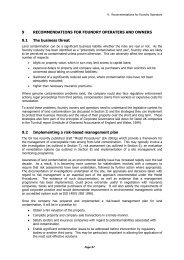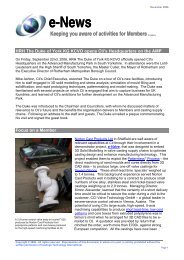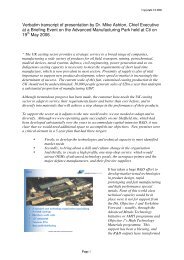The Replicast Process* - Castings Technology International
The Replicast Process* - Castings Technology International
The Replicast Process* - Castings Technology International
You also want an ePaper? Increase the reach of your titles
YUMPU automatically turns print PDFs into web optimized ePapers that Google loves.
<strong>The</strong> <strong>Replicast</strong> ® <strong>Process*</strong>More than 20 years ago, Cti developed a variant of Lost Foam technology thatenabled numerous Members of the organisation to achieve sustainable success withthe process. By deploying a vacuum to the moulding box in a novel manner, itproved possible to take the process off the ‘knife-edge’ and overcome severallimitations. This approach has been adopted commercially, and Cti is currentlyproject-managing the expansion of several Lost Foam operations in Memberfoundries, including the supply of purpose-designed equipment.Cti always embody a disclaimer in Licence Agreements to the effect that the LostFoam Process cannot and should not be used to manufacture steel castings.Exhaustive metallurgical investigations over many years have proven irrefutably that,with the exception of certain heat-resistant alloys, carbon pick-up from thepolystyrene contaminates most steel grades, producing regions within a castingwhere the mechanical properties are so inferior that catastrophic service failure canoccur.<strong>The</strong> <strong>Replicast</strong> ® Process eliminates this problem by building up a ceramic shell on thepolystyrene pattern. On firing the ceramic, all traces of the polystyrene are removedbefore the mould is embedded in the supporting un-bonded sand. In many respects,the process is akin to the Lost Wax process but with certain key differentiatingcharacteristics. For example, polystyrene is lighter and relatively insensitive totemperature; patterns can be produced in very thin or thick walls (2-200mm);complex shapes can be formed by gluing sections, affording the design freedom ofthe Lost Foam process; the physical properties of polystyrene allow a much thinnerceramic shell to be produced; the <strong>Replicast</strong> ® Process pre-empts the requirement topre-heat the ceramic mould before pouring; and so on.Because the polystyrene is removed from the mould, a higher density pattern can beproduced. This allows superior dimensional accuracy and surface finish to beachieved, equivalent in both respects to Lost Wax. Moreover, the lighter patternsand ceramic moulds, and the elimination of the need to pre-heat the moulds, allowsmuch larger castings to be produced than realistically possible in any Lost Waxoperation. <strong>Castings</strong> weighing in excess of 500kg, with a poured weight in excess of1 tonne, are produced at Cti in product and process development activities, and byseveral users of <strong>Replicast</strong> ® .Thus, the <strong>Replicast</strong> ® Process has enabled steel castings of a size commonlyassociated with sand moulding to be manufactured in a way that achieves the ascastintegrity, surface finish and dimensional accuracy associated with the Lost Waxprocess. And this has been achieved at lower cost, especially in end-productmanufacturing cost, compared with traditional sand castings. <strong>The</strong> competitivenessand performance of <strong>Replicast</strong> ® components has resulted in numerous conversions offorgings and fabrications to castings.Compared with a sand casting, <strong>Replicast</strong> ® can achieve a weight reduction commonlyas high as 25%; a 50% reduction of feed metal is typically obtained; 40% more
castings per melt can be expected; fettling and finishing costs can be reduced bymore than 30%; all of which data have been fed back to Cti from licensees.<strong>The</strong> Process is environmentally attractive. Waste streams are much reduced: theceramic : metal ratio is just 0.12:1 compared with, say, a typical sand : metal ratio of5:1. Noise, emissions, materials and energy consumption are significantly lower.<strong>The</strong> elimination of core print and parting line flash, combined with the opportunity toplace feeder heads, etc. on flat surfaces (commonly surfaces to be machined),allows them to be removed by sawing, thereby mitigating Hand-Arm Vibration issues;many traditional labour skills are not required; output per unit area of floor space issignificantly increased; and so on.<strong>The</strong> higher as-cast integrity (increased soundness, virtual elimination of hot-tears,gas defects and inclusions) reduces rectification and upgrading costs and lowerswork-in-progress. This facilitates shorter lead-times and on-time delivery which,combined with the quality and a 45% reduction in machining costs, renders<strong>Replicast</strong> ® components very attractive to many market sectors.<strong>The</strong> market interest in the technology is reflected in the current expansion in capacityof licensees, in which Cti is intimately involved. Cti has many years of experience insupporting adoption of the Process and increasing capacity, including market andproduct appraisal; development and manufacture of tooling and castings; design andsupply of plant and equipment (including the construction of completely newfoundries); interim supply of patterns (and castings); training of operatives; andcontinuing process development.Current process developments include a radically new way of manufacturing large,rangy patterns with walls as thin as 2mm to exacting dimensional standards; a newway of handling patterns during the manufacture of very large shells; and faster waysto machine one-off patterns directly in polystyrene for low-volume production. <strong>The</strong>latter two projects have reached the stage of commercial exploitation, two licenseeshaving already adopted these technology updates.Cti’s confidence in the future of the <strong>Replicast</strong> ® Process is evident from the decisionto construct a 40,000 sq.ft. building next to its headquarters on the AdvancedManufacturing Park in South Yorkshire to house a state-of-the-art ‘technologydemonstrator’ that will exhibit all the attributes of the Process, especially its greencredentials.For further information on the <strong>Replicast</strong> ® Process, please contact:Dr. Mike Ashton, Chief Executive,<strong>Castings</strong> <strong>Technology</strong> <strong>International</strong>Advanced Manufacturing Park, Brunel Way, Rotherham, S60 5WG, UK.t. +44 (0)114 2541144 f. +44 (0)114 2541155e. m.ashton@castingstechnology.comwww.castingstechnology.com∗ <strong>Replicast</strong> ® is a Registered Trade Mark of <strong>Castings</strong> <strong>Technology</strong> <strong>International</strong>.
This 228kg Blowout Preventer is a conversion from a forged/machined product,and was produced from a 6-coat, <strong>Replicast</strong> ® ceramic shell mould<strong>The</strong> as-cast form of supply of a 117kg, 6-inch control valve manufactured in a 6-coat,<strong>Replicast</strong> ® ceramic shell mould to ‘lost wax standards’






